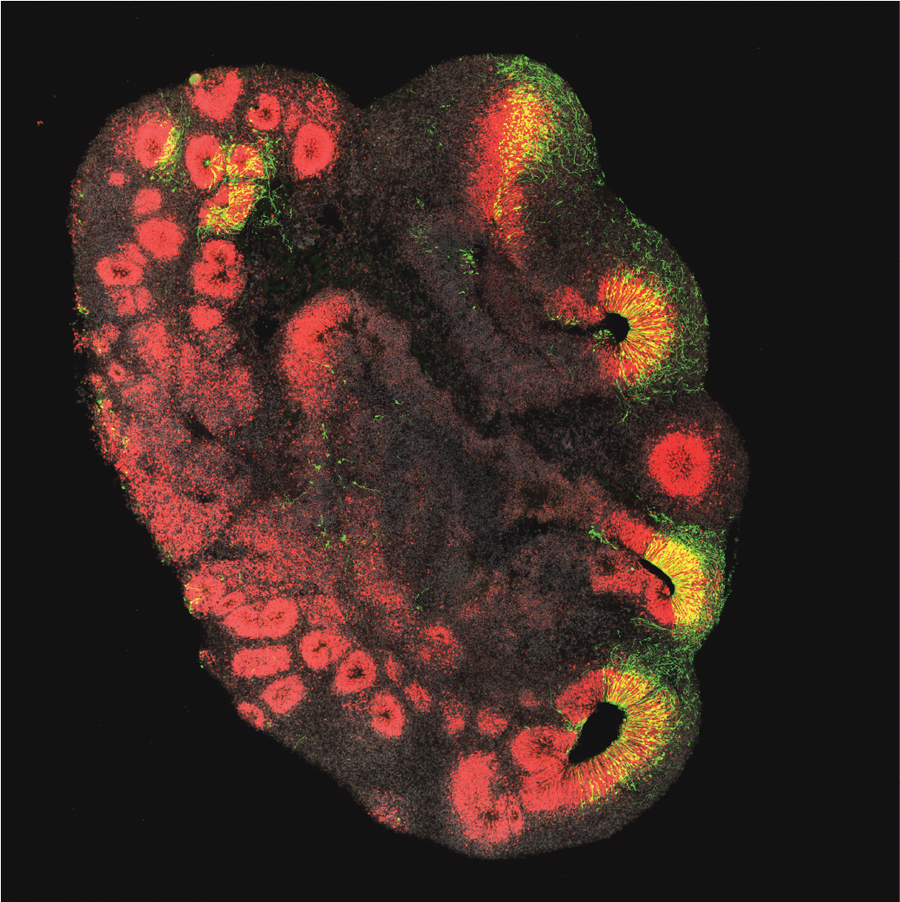
A brain organoid about 3 millimeters in size made from stem cells of a chimpanzee. The brain stem cells are stained red; brain stem cells that received the ARHGAP11B gene are shown in green. Photo: Jan Fischer
ARHGAP11B - this complex name is given to a gene that is found only in humans and plays an essential role in the enlargement of the developing neocortex. The neocortex is the part of the brain to which we owe our high mental abilities. The importance of ARHGAP11B in neocortex development during human evolution has been investigated by a team of researchers from the German Primate Center (DPZ) - Leibniz Institute for Primate Research in Göttingen, the Max Planck Institute for Molecular Cell Biology and Genetics (MPI-CBG) in Dresden and the Hector Institute for Translational Brain Research (HITBR) in Mannheim. To do this, the research team introduced ARHGAP11B, and thus for the first time a gene that exists only in humans, into laboratory-grown brain organoids of our closest living relatives, chimpanzees. In the chimpanzee brain organoid, the ARHGAP11B gene led to an increase in brain stem cells relevant for brain growth and to an increase in those neurons that play a crucial role in the extraordinary mental abilities of humans. In contrast, when either the ARHGAP11B gene was knocked out in human brain organoids or the function of the ARHGAP11B protein was inhibited in them, the amount of these brain stem cells decreased to the level of a chimpanzee. Thus, the research team was able to show that the ARHGAP11B gene played a crucial role in the evolution of the brain from our ancestors to modern humans (EMBO reports).
Animal studies on great apes have long been banned in Europe for ethical reasons. An alternative are so-called organoids, i.e. three-dimensional cell structures a few millimeters in size that are grown in the laboratory. These organoids can be produced from so-called pluripotent stem cells, which then differentiate into specific cell types, such as nerve cells. In this way, the research team was able to produce both chimpanzee brain organoids and human brain organoids. "These brain organoids allowed us to investigate a central question concerning ARHGAP11B" says Wieland Huttner of the MPI-CBG, one of the three lead authors of the study. "In a previous study together with Michael Heide, we were able to show that ARHGAP11B can enlarge a primate brain. However, it was previously unclear whether ARHGAP11B had a major or minor role in the evolutionary enlargement of the human neocortex. "To clarify this, the ARHGAP11B gene was either introduced into brain ventricle-like structures of chimpanzee organoids, or it was knocked out in human brain organoids, or the function of the ARHGAP11B protein was blocked by a related inhibitory protein. Would the ARHGAP11B gene lead to the proliferation of those brain stem cells in the chimpanzee brain that are necessary for the enlargement of the neocortex? "Our study shows that the gene in chimpanzee organoids causes an increase in relevant brain stem cells and an increase in those neurons that play a crucial role in the extraordinary mental abilities of humans," says Michael Heide, the study's lead author, who is head of the Junior Research Group Brain Development and Evolution at the DPZ, in collaboration with the MPI-CBG. When the ARHGAP11B gene was knocked out in human brain organoids or the function of the ARHGAP11B protein was inhibited, the amount of these brain stem cells decreased to the level of a chimpanzee. "We were thus able to show that ARHGAP11B plays a crucial role in neocortex development during human evolution," says Michael Heide. Adds Julia Ladewig of HITBR, the third of the lead authors: "Given this important role of ARHGAP11B, it is furthermore conceivable that certain maldevelopments of the neocortex may be caused by mutations in this gene."
Press Release of the German Primate Center
Fischer J, Fernandez Ortuno E, Marsoner F, Artioli A, Peters J, Namba T, Eugster Oegema C, Huttner WB, Ladewig J, Heide M (2022): Human-specific ARHGAP11B ensures human-like basal progenitor levels in hominid cerebral organoids. EMBO reports, doi: 10.15252/embr.202254728